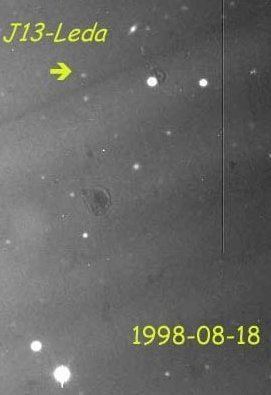Adjectives Ledean Eccentricity 0.16 Discovered 11 September 1974 | Discovery date September 11, 1974 Mean orbit radius 11,160,000 km Orbital period 240.92 d (0.654 a) Mean radius 10,000 m Discoverer Charles T. Kowal Apparent magnitude 20.2 | |
 | ||
Similar Jupiter moons, Other celestial objects | ||
Leda (/ˈliːdə/ LEE-də; Greek: Λήδα), also known as Jupiter XIII, is a prograde irregular satellite of Jupiter. It was discovered by Charles T. Kowal at the Mount Palomar Observatory on September 14, 1974, after three nights' worth of photographic plates had been taken (September 11 through 13; Leda appears on all of them). It was named after Leda, who was a lover of Zeus, the Greek equivalent of Jupiter (who came to her in the form of a swan). Kowal suggested the name and the IAU endorsed it in 1975.
Leda belongs to the Himalia group, five moons orbiting between 11 and 13 Gm from Jupiter at an inclination of about 27.5°. The orbital elements given here are as of January 2000, but they are continuously changing due to solar and planetary perturbations.
